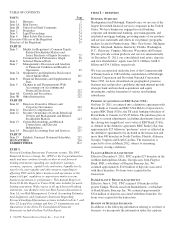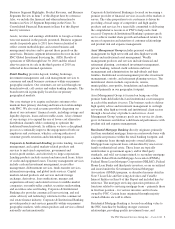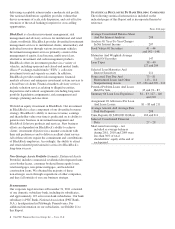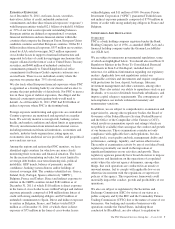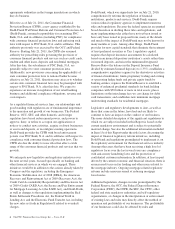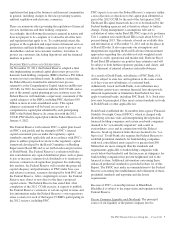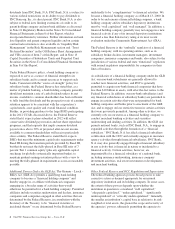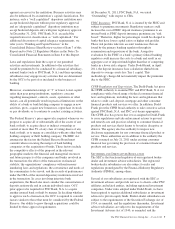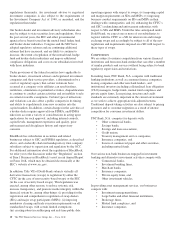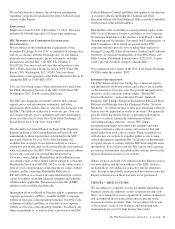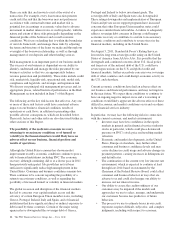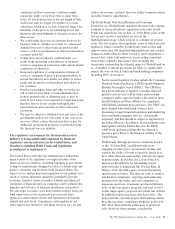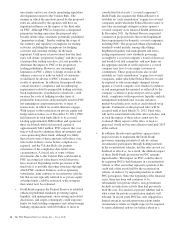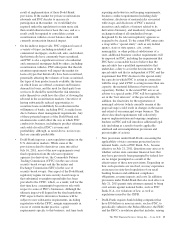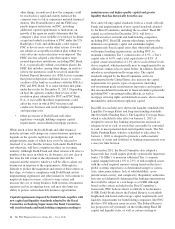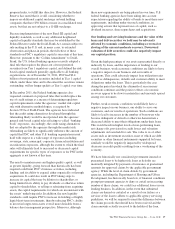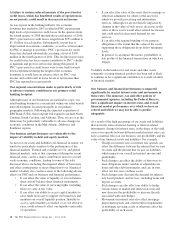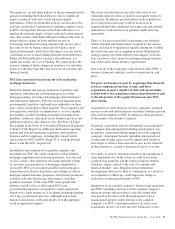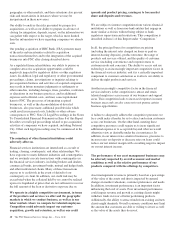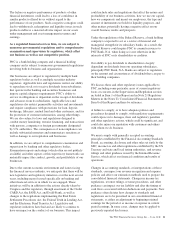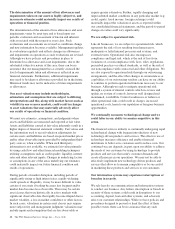PNC Bank 2011 Annual Report Download - page 21
Download and view the complete annual report
Please find page 21 of the 2011 PNC Bank annual report below. You can navigate through the pages in the report by either clicking on the pages listed below, or by using the keyword search tool below to find specific information within the annual report.There are risks that are known to exist at the outset of a
transaction. For example, every loan transaction presents
credit risk (the risk that the borrower may not perform in
accordance with contractual terms) and market risk (a
potential loss in earnings or economic value due to adverse
movement in market interest rates or credit spreads), with the
nature and extent of these risks principally depending on the
financial profile of the borrower and overall economic
conditions. We focus on lending that is within the boundaries
of our risk framework, and manage these risks by adjusting
the terms and structure of the loans we make and through our
oversight of the borrower relationship, as well as through
management of our deposits and other funding sources.
Risk management is an important part of our business model.
The success of our business is dependent on our ability to
identify, understand and manage the risks presented by our
business activities so that we can appropriately balance
revenue generation and profitability. These risks include credit
risk, market risk, liquidity risk, operational risk, model risk,
compliance and legal risk, and strategic and reputation risk.
We discuss our principal risk management processes and, in
appropriate places, related historical performance in the Risk
Management section included in Item 7 of this Report.
The following are the key risk factors that affect us. Any one
or more of these risk factors could have a material adverse
impact on our business, financial condition, results of
operations or cash flows, in addition to presenting other
possible adverse consequences, which are described below.
These risk factors and other risks are also discussed further in
other sections of this Report.
The possibility of the moderate economic recovery
returning to recessionary conditions or of turmoil or
volatility in the financial markets would likely have an
adverse effect on our business, financial position and
results of operations.
Although the United States economy has shown modest
improvement recently, economic conditions continue to pose a
risk to financial institutions, including PNC. The economic
recovery, although continuing, did so at a slower pace in 2011
than previously anticipated. Job growth has not yet been
sufficient to significantly reduce high unemployment in the
United States. Consumer and business confidence remains low.
There continues to be concern regarding the possibility of a
return to recessionary conditions, as well as regarding the
possibility of increased turmoil or volatility in financial markets.
The global recession and disruption of the financial markets
has led to concerns over capital markets access and the
solvency of certain European Union member states, including
Greece, Portugal, Ireland, Italy and Spain, and of financial
institutions that have significant direct or indirect exposure to
debt issued by these countries. Certain of the major rating
agencies have downgraded the sovereign debt of Greece,
Portugal and Ireland to below investment grade. The
sovereign debt of Italy and Spain were also downgraded.
These ratings downgrades and implementation of European
Union and private sector support programs have increased
concerns that other European Union member states could
experience similar financial troubles. A failure to adequately
address sovereign debt concerns in Europe could hamper
economic recovery or contribute to a return to recessionary
economic conditions and contribute to severe stress in the
financial markets, including in the United States.
On August 5, 2011, Standard & Poors’s Rating Services
lowered its long term sovereign credit rating on the United
States of America from AAA to AA+. It is possible that the
downgrade and continued concerns about U.S. fiscal policy
and trajectory of the national debt of the U.S. could have
severe repercussions on the U.S. and global credit and
financial markets, further exacerbate concerns over sovereign
debt of other countries and could disrupt economic activity in
the U.S. and elsewhere.
Current economic conditions have had an adverse effect on
our business and financial performance and may not improve
in the near future. We expect these conditions to continue to
have an ongoing negative impact on us and a worsening of
conditions would likely aggravate the adverse effects of these
difficult economic and market conditions on us and on others
in the financial services industry.
In particular, we may face the following risks in connection
with the current economic and market environment:
• Investors may have less confidence in the equity
markets in general and in financial services industry
stocks in particular, which could place downward
pressure on PNC’s stock price and resulting market
valuation.
• Economic and market developments, in the United
States, Europe or elsewhere, may further affect
consumer and business confidence levels and may
cause declines in credit usage and adverse changes in
payment patterns, causing increases in delinquencies
and default rates.
• The continuation of the current very low interest rate
environment, which is expected to continue at least
through late 2014 based on statements by the
Chairman of the Federal Reserve Board, could affect
consumer and business behavior in ways that are
adverse to us and could also hamper our ability to
increase our net interest income.
• Our ability to assess the creditworthiness of our
customers may be impaired if the models and
approaches we use to select, manage, and underwrite
our customers become less predictive of future
behaviors.
• The process we use to estimate losses in our credit
exposures requires difficult, subjective, and complex
judgments, including with respect to economic
12 The PNC Financial Services Group, Inc. – Form 10-K


